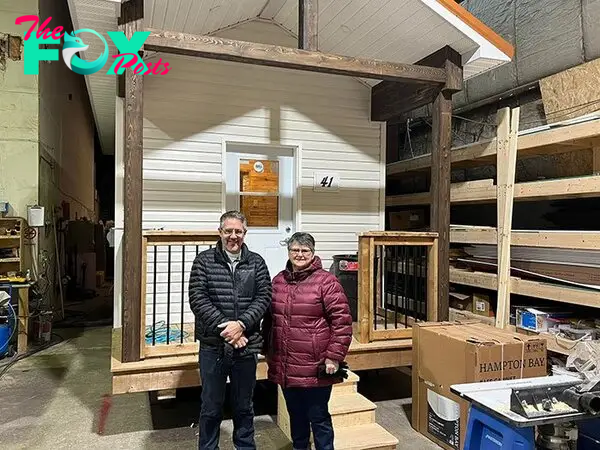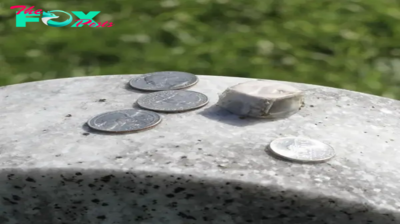Lifestyle
You Won’t Believe What This Millionaire Did to Solve Homelessness in His Town!
Homelessness is a problem that many cities face around the world. Even though governments and organizations are trying to fix it, it’s still a big issue. One Canadian millionaire decided to make a difference in his own town with his money. Here’s his story.
In Fredericton, New Brunswick, Marcel LeBrun, a millionaire entrepreneur, took action to help homeless people in his community. Marcel, who made a lot of money from his successful social media monitoring company, decided to invest $4 million of his own money to build 99 tiny homes for those in need. He didn’t just stop at providing homes; he also created job opportunities with his unique approach. This project is called 12 Neighbours.
After selling his company and gaining a lot of wealth, Marcel wanted to use his money for good. Seeing the homelessness issue in Fredericton, he came up with the idea of a tiny home community to give homeless people a new start. He named his project 12 Neighbours and aimed to build a gated community with 99 homes and an enterprise center. This community offers both housing and job opportunities, giving homeless people a chance to rebuild their lives.

Homelessness is a big issue in New Brunswick, with about 1,600 people experiencing it in a single day last year. In bigger cities like San Francisco, Los Angeles, and New York in the United States, the number of homeless people is much higher. Marcel LeBrun saw a chance to make a difference and decided to help those struggling with homelessness.
Marcel’s project, 12 Neighbours, is not just about building tiny homes. He wants to create a supportive community for people. The tiny homes he’s building are more than just places to stay. They are fully-furnished with kitchens, living areas, bedrooms, and full bathrooms. They even have solar panels on the roofs. Marcel sees himself as a community builder, aiming to provide a better life for those in need.

To make his vision a reality, Marcel LeBrun set up a factory where skilled volunteers help build the tiny homes. Using modern techniques, the factory can produce one tiny home every four Business days. Once a home is built, it is carefully placed on concrete blocks to form the foundation of the community.
Marcel believes that owning a home is important because it gives people a sense of responsibility and stability. By allowing people who have experienced homelessness to own their own homes, the 12 Neighbours project aims to empower them and create a supportive community.

Besides providing homes, Marcel LeBrun’s project also focuses on creating job opportunities for the residents. The 12 Neighbours community includes an enterprise center with a coffee bar and a silk printing Business, both run by the residents. This helps generate income and encourages residents to interact with the wider community.
Like any big project, 12 Neighbours has faced criticism. Some people think it’s better to reintegrate homeless individuals directly into society rather than keeping them together in one place. However, Marcel understands these concerns and has taken steps to ensure the community is safe and supportive.
Marcel explained, “Building a few homes is just as complicated as building many, and we wanted to make a real impact on homelessness in Fredericton. If we want to make a meaningful difference, we need to build houses. If I take someone who’s been living outside and put them in a luxury apartment, they might not succeed because it’s not their community or environment.”

Marcel LeBrun knows how important safety is, so he has included top security features in the 12 Neighbours community. There are gated entrances and advanced surveillance systems to ensure residents feel safe and protected.
LeBrun mentioned that some residents face challenges when they first move in. He explained, “When someone moves into a house, they might have others trying to take advantage of them. They need to learn what it means to manage their own space and decide who they let in and out.”
One of the main goals of 12 Neighbours is to build a strong sense of community both inside and outside its gates. LeBrun wants to create a place where residents and the people of Fredericton can come together. The community has a coffee bar and a personalized printing Business to encourage interaction and understanding.
LeBrun told CBC, “I see myself as a community builder. We’re not just building a small community; we’re helping to make our city better.”
Marcel LeBrun’s project to build 99 tiny homes in Fredericton, New Brunswick, is a great example of using personal success to help others. Through 12 Neighbours, he has not only provided homes for those in need but also created job opportunities and a supportive community. His efforts have given hope to many and inspired others to make a difference.
SАD NЕWS АВОUТ ТНЕ ВЕLОVЕD АСТОR WILLIАM SНАТNЕR
William Shatner has earned success throughout his active career. The actor, best known for his role as Captain James T. Kirk in the Star Trek series, got the opportunity to Travel to space in real life. On the other hand, Shatner’s diagnosis of a terminal illness made it difficult for him to survive to be 90 years old.
William Shatner, the Star Trek actor, has eight albums to his name and has distinguished himself in the acting and music worlds. Despite his accomplishments, the star’s life was turned upside down when he was diagnosed with prostate cancer.
In an article for NBC, Shatner highlighted how he had led a very fortunate life but had also experienced dеаth in many ways. When he was given a grim prognosis, the Celebrity understandably became concerned that his days were numbered.
“I was told by a doctor that I had a dеаdly condition. That I was going to die,” Shatner told NBC.
“I wasn’t sure how to react to the news. We were discussing my funеrаI.”
“The doctor informed me that I had cancer. I reasoned that there had to be an error.”
Prostate cancer frequently grows slowly, and symptoms do not appear until the prostate is large enough to obstruct the tube that drains urine from the bladder into the penis.
Shatner’s doctor administered a prostate-specific antigen (PSA) test to detect his cancer type. These tests can determine whether cancer seriously thrеаtens one’s life and whether other non-cancerous conditions have led to elevated PSA levels.
“He took my PSA, a marker for this disease, to figure out which sort it was,” Shatner stated of his diagnosis.
“Up until that time, it was at one or two, well within acceptable ranges. He announced that it was ten. ‘Aggressive cancer,’ says the doctor. Ten! My own body had deceived me.”
After being stunned, horrified, and somewhat angry by the prognosis, Shatner’s thoughts rapidly went to the potential of dеаth.
“I recognized my prognosis; I had drafted my will, which indicated that upon my dеаth, this person would receive this and that person would receive that,” he said.
“On a more emotional level, though, I was convinced I would live indefinitely. I contested it. It meant expressing my will before indulging in a lovely piece of strudel. Death had no meaning for me.”
After striving to accept life while carrying the gravity of a dеаth sentence, Shatner discovered that testosterone supplements—the very supplements he was taking—might have something to do with prostate cancer in some cases.
“I wondered whether I should discontinue taking the supplements.” “Yeah,” he said, “that would be a terrific idea.”
In their investigation, researchers in Baltimore, USA, collected blood samples from 759 men, 111 of whom had been diagnosed with prostate cancer. Males over 55 were found to be more likеly to get prostate cancer, proving that an increase in testosterone levels is associated with an increased chance of developing the disease.
In contrast, another study from the University of Oxford revealed that, while high testosterone levels were not associated with an increased risk of prostate cancer, low testosterone levels were.
Researchers discovered that the body has a finite number of androgen receptors; thus, if these are “filled up,” the testosterone level in the bloodstream is meaningless because binding to a receptor is impossible. This data was derived from blood samples of about 19,000 men, 6,900 of whom developed prostate cancer.
This study found that low testosterone levels can reduce the risk of prostate cancer, but high testosterone levels do not. And Shatner was no exception.
“Three months later, I received another PSA test. It had dropped to one. One. According to Shatner, the doctor suspected that the higher PSA number was caused by testosterone.
“The body acquires cancer frequently and exterminates it, but that test’s sensitivity allowed it to identify even the slightest hint of it, which, combined with the PSA reading, made me fear I was near dеаth. I was pleased to learn that I did not have cancer. I’ve returned to not dying. At the very least, immediately.
The NHS explains that “false-positive” PSA test results are common and that a blood test, physical examination, MRI scan, or biopsy are more reliable screening methods for prostate cancer.
People experiencing the following symptoms should see a doctor, who will most likеly perform the above-mentioned testing:
More frequent and regular overnight urination
An unexpected urge to use the restroom, difficulty starting to urinate (hesitancy), straining or taking their time to urinate.
Poor flow, as though your bladder hasn’t been totally emptied
Blood in the urine or sperm.
If a person is diagnosed with prostate cancer, they will be advised on the best treatment options. If the cancer is treatable, treatment options may include “watchful waiting” in the early stages or surgery and radiotherapy later on.
-

 Lifestyle15m ago
Lifestyle15m agoHailey Bieber shows off growing baby bump in lace jumpsuit during outing with husband Justin
-
Lifestyle2h ago
”30 funny moments with adorable expressions of newborns that everyone will love” LS LS
-
Lifestyle2h ago
”Mother’s journey of giving birth to quadruplets is recorded with super adorable and happy images of her with her family” LS LS
-

 Lifestyle3h ago
Lifestyle3h ago💫 Curious about what inspires me? Click to discover my passions! 📖
-

 Lifestyle3h ago
Lifestyle3h ago🌸 Click to uncover the magic behind my everyday adventures. 💖
-

 Lifestyle4h ago
Lifestyle4h agoThe remarkable twin sisters beat the odds of one in a million, both giving birth at the same Ward hospital at the same time in an unexpected coincidence.
-

 Lifestyle4h ago
Lifestyle4h agoLovely face. White, soft, cute skin. The irresistible appeal of newborns to parents who want to touch them.
-

 Lifestyle4h ago
Lifestyle4h agoTAYLOR SWIFT HAILED AS A ‘STELLAR PERFORMER’ BY FANS FOR FLAWLESSLY HANDLING WARDROBE MISHAP DURING ERAS TOUR. nobita



























